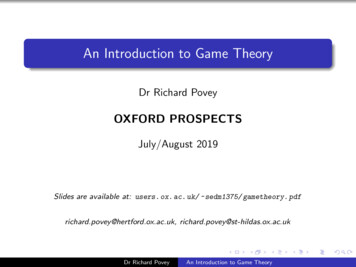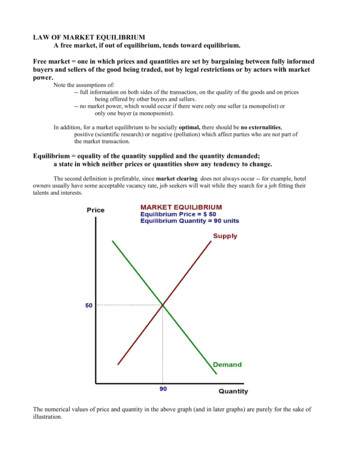
Transcription
Draft chapter from An introduction to game theory by Martin J. Osborne. Version: nomics.utoronto.ca/osborneCopyright 1995–2002 by Martin J. Osborne. All rights reserved. No part of this book may be reproduced by any electronic or mechanical means (including photocopying, recording, or informationstorage and retrieval) without permission in writing from Oxford University Press, except that onecopy of up to six chapters may be made by any individual for private study.2Nash Equilibrium: Theory2.12.22.32.42.52.62.72.82.92.10Strategic games 11Example: the Prisoner’s Dilemma 12Example: Bach or Stravinsky? 16Example: Matching Pennies 17Example: the Stag Hunt 18Nash equilibrium 19Examples of Nash equilibrium 24Best response functions 33Dominated actions 43Equilibrium in a single population: symmetric games andsymmetric equilibria 49Prerequisite: Chapter 1.2.1 Strategic gamesis a model of interacting decision-makers. In recognitionof the interaction, we refer to the decision-makers as players. Each playerhas a set of possible actions. The model captures interaction between the playersby allowing each player to be affected by the actions of all players, not only herown action. Specifically, each player has preferences about the action profile—thelist of all the players’ actions. (See Section 17.4, in the mathematical appendix, fora discussion of profiles.)More precisely, a strategic game is defined as follows. (The qualification “withordinal preferences” distinguishes this notion of a strategic game from a moregeneral notion studied in Chapter 4.)ASTRATEGIC GAMEI D EFINITION 11.1 (Strategic game with ordinal preferences) A strategic game (withordinal preferences) consists of a set of players for each player, a set of actions for each player, preferences over the set of action profiles.11
12Chapter 2. Nash Equilibrium: TheoryA very wide range of situations may be modeled as strategic games. For example, the players may be firms, the actions prices, and the preferences a reflection ofthe firms’ profits. Or the players may be candidates for political office, the actionscampaign expenditures, and the preferences a reflection of the candidates’ probabilities of winning. Or the players may be animals fighting over some prey, the actions concession times, and the preferences a reflection of whether an animal winsor loses. In this chapter I describe some simple games designed to capture fundamental conflicts present in a variety of situations. The next chapter is devoted tomore detailed applications to specific phenomena.As in the model of rational choice by a single decision-maker (Section 1.2), it isfrequently convenient to specify the players’ preferences by giving payoff functionsthat represent them. Bear in mind that these payoffs have only ordinal significance.If a player’s payoffs to the action profiles a, b, and c are 1, 2, and 10, for example,the only conclusion we can draw is that the player prefers c to b and b to a; thenumbers do not imply that the player’s preference between c and b is strongerthan her preference between a and b.Time is absent from the model. The idea is that each player chooses her action once and for all, and the players choose their actions “simultaneously” in thesense that no player is informed, when she chooses her action, of the action chosenby any other player. (For this reason, a strategic game is sometimes referred toas a “simultaneous move game”.) Nevertheless, an action may involve activitiesthat extend over time, and may take into account an unlimited number of contingencies. An action might specify, for example, “if company X’s stock falls below 10, buy 100 shares; otherwise, do not buy any shares”. (For this reason, an actionis sometimes called a “strategy”.) However, the fact that time is absent from themodel means that when analyzing a situation as a strategic game, we abstract fromthe complications that may arise if a player is allowed to change her plan as eventsunfold: we assume that actions are chosen once and for all.2.2 Example: the Prisoner’s DilemmaOne of the most well-known strategic games is the Prisoner’s Dilemma. Its namecomes from a story involving suspects in a crime; its importance comes from thehuge variety of situations in which the participants face incentives similar to thosefaced by the suspects in the story.E XAMPLE 12.1 (Prisoner’s Dilemma) Two suspects in a major crime are held in separate cells. There is enough evidence to convict each of them of a minor offense,but not enough evidence to convict either of them of the major crime unless one ofthem acts as an informer against the other (finks). If they both stay quiet, each willbe convicted of the minor offense and spend one year in prison. If one and onlyone of them finks, she will be freed and used as a witness against the other, whowill spend four years in prison. If they both fink, each will spend three years inprison.
2.2 Example: the Prisoner’s Dilemma13This situation may be modeled as a strategic game:Players The two suspects.Actions Each player’s set of actions is {Quiet, Fink}.Preferences Suspect 1’s ordering of the action profiles, from best to worst, is(Fink, Quiet) (she finks and suspect 2 remains quiet, so she is freed), (Quiet,Quiet) (she gets one year in prison), (Fink, Fink) (she gets three years in prison),(Quiet, Fink) (she gets four years in prison). Suspect 2’s ordering is (Quiet, Fink),(Quiet, Quiet), (Fink, Fink), (Fink, Quiet).We can represent the game compactly in a table. First choose payoff functionsthat represent the suspects’ preference orderings. For suspect 1 we need a functionu1 for whichu1 (Fink, Quiet) u1 (Quiet, Quiet) u 1 (Fink, Fink) u1 (Quiet, Fink).A simple specification is u 1 (Fink, Quiet) 3, u 1 (Quiet, Quiet) 2, u 1 (Fink, Fink) 1, and u1 (Quiet, Fink) 0. For suspect 2 we can similarly choose the functionu2 for which u2 (Quiet, Fink) 3, u 2 (Quiet, Quiet) 2, u 2 (Fink, Fink) 1, andu2 (Fink, Quiet) 0. Using these representations, the game is illustrated in Figure 13.1. In this figure the two rows correspond to the two possible actions ofplayer 1, the two columns correspond to the two possible actions of player 2, andthe numbers in each box are the players’ payoffs to the action profile to which thebox corresponds, with player 1’s payoff listed first.Suspect 1QuietFinkSuspect 2Quiet Fink2, 20, 33, 01, 1Figure 13.1 The Prisoner’s Dilemma (Example 12.1).The Prisoner’s Dilemma models a situation in which there are gains from cooperation (each player prefers that both players choose Quiet than they both chooseFink) but each player has an incentive to “free ride” (choose Fink) whatever theother player does. The game is important not because we are interested in understanding the incentives for prisoners to confess, but because many other situationshave similar structures. Whenever each of two players has two actions, say C(corresponding to Quiet) and D (corresponding to Fink), player 1 prefers (D, C) to(C, C) to (D, D) to (C, D), and player 2 prefers (C, D) to (C, C) to (D, D) to (D, C),the Prisoner’s Dilemma models the situation that the players face. Some examplesfollow.2.2.1 Working on a joint projectYou are working with a friend on a joint project. Each of you can either work hardor goof off. If your friend works hard then you prefer to goof off (the outcome of
14Chapter 2. Nash Equilibrium: Theorythe project would be better if you worked hard too, but the increment in its valueto you is not worth the extra effort). You prefer the outcome of your both workinghard to the outcome of your both goofing off (in which case nothing gets accomplished), and the worst outcome for you is that you work hard and your friendgoofs off (you hate to be “exploited”). If your friend has the same preferences thenthe game that models the situation you face is given in Figure 14.1, which, as youcan see, differs from the Prisoner’s Dilemma only in the names of the actions.Work hardGoof offWork hard2, 23, 0Goof off0, 31, 1Figure 14.1 Working on a joint project.I am not claiming that a situation in which two people pursue a joint projectnecessarily has the structure of the Prisoner’s Dilemma, only that the players’ preferences in such a situation may be the same as in the Prisoner’s Dilemma! If, forexample, each person prefers to work hard than to goof off when the other personworks hard, then the Prisoner’s Dilemma does not model the situation: the players’preferences are different from those given in Figure 14.1.? E XERCISE 14.1 (Working on a joint project) Formulate a strategic game that modelsa situation in which two people work on a joint project in the case that their preferences are the same as those in the game in Figure 14.1 except that each personprefers to work hard than to goof off when the other person works hard. Presentyour game in a table like the one in Figure 14.1.2.2.2 DuopolyIn a simple model of a duopoly, two firms produce the same good, for which eachfirm charges either a low price or a high price. Each firm wants to achieve thehighest possible profit. If both firms choose High then each earns a profit of 1000.If one firm chooses High and the other chooses Low then the firm choosing Highobtains no customers and makes a loss of 200, whereas the firm choosing Lowearns a profit of 1200 (its unit profit is low, but its volume is high). If both firmschoose Low then each earns a profit of 600. Each firm cares only about its profit,so we can represent its preferences by the profit it obtains, yielding the game inFigure 14.2.HighLowHigh1000, 10001200, 200Low 200, 1200600, 600Figure 14.2 A simple model of a price-setting duopoly.Bearing in mind that what matters are the players’ preferences, not the partic-
2.2 Example: the Prisoner’s Dilemma15ular payoff functions that we use to represent them, we see that this game, like theprevious one, differs from the Prisoner’s Dilemma only in the names of the actions.The action High plays the role of Quiet, and the action Low plays the role of Fink;firm 1 prefers (Low, High) to (High, High) to (Low, Low) to (High, Low), and firm 2prefers (High, Low) to (High, High) to (Low, Low) to (Low, High).As in the previous example, I do not claim that the incentives in a duopoly arenecessarily those in the Prisoner’s Dilemma; different assumptions about the relativesizes of the profits in the four cases generate a different game. Further, in this caseone of the abstractions incorporated into the model—that each firm has only twoprices to choose between—may not be harmless; if the firms may choose amongmany prices then the structure of the interaction may change. (A richer model isstudied in Section 3.2.)2.2.3 The arms raceUnder some assumptions about the countries’ preferences, an arms race can bemodeled as the Prisoner’s Dilemma. (The Prisoner’s Dilemma was first studied inthe early 1950s, when the USA and USSR were involved in a nuclear arms race, soyou might suspect that US nuclear strategy was influenced by game theory; theevidence suggests that it was not.) Assume that each country can build an arsenalof nuclear bombs, or can refrain from doing so. Assume also that each country’sfavorite outcome is that it has bombs and the other country does not; the next bestoutcome is that neither country has any bombs; the next best outcome is that bothcountries have bombs (what matters is relative strength, and bombs are costly tobuild); and the worst outcome is that only the other country has bombs. In thiscase the situation is modeled by the Prisoner’s Dilemma, in which the action Don’tbuild bombs corresponds to Quiet in Figure 13.1 and the action Build bombs corresponds to Fink. However, once again the assumptions about preferences necessaryfor the Prisoner’s Dilemma to model the situation may not be satisfied: a countrymay prefer not to build bombs if the other country does not, for example (bombbuilding may be very costly), in which case the situation is modeled by a differentgame.2.2.4 Common propertyTwo farmers are deciding how much to allow their sheep to graze on the villagecommon. Each farmer prefers that her sheep graze a lot than a little, regardless ofthe other farmer’s action, but prefers that both farmers’ sheep graze a little thanboth farmers’ sheep graze a lot (in which case the common is ruined for futureuse). Under these assumptions the game is the Prisoner’s Dilemma. (A richer modelis studied in Section 3.1.5.)
16Chapter 2. Nash Equilibrium: Theory2.2.5 Other situations modeled as the Prisoner’s DilemmaA huge number of other situations have been modeled as the Prisoner’s Dilemma,from mating hermaphroditic fish to tariff wars between countries.? E XERCISE 16.1 (Hermaphroditic fish) Members of some species of hermaphroditicfish choose, in each mating encounter, whether to play the role of a male or afemale. Each fish has a preferred role, which uses up fewer resources and henceallows more future mating. A fish obtains a payoff of H if it mates in its preferredrole and L if it mates in the other role, where H L. (Payoffs are measured interms of number of offspring, which fish are evolved to maximize.) Consider anencounter between two fish whose preferred roles are the same. Each fish has twopossible actions: mate in either role, and insist on its preferred role. If both fishoffer to mate in either role, the roles are assigned randomly, and each fish’s payoffis 12 (H L) (the average of H and L). If each fish insists on its preferred role, thefish do not mate; each goes off in search of another partner, and obtains the payoffS. The higher the chance of meeting another partner, the larger is S. Formulate thissituation as a strategic game and determine the range of values of S, for any givenvalues of H and L, for which the game differs from the Prisoner’s Dilemma only inthe names of the actions.2.3 Example: Bach or Stravinsky?In the Prisoner’s Dilemma the main issue is whether or not the players will cooperate(choose Quiet). In the following game the players agree that it is better to cooperatethan not to cooperate, but disagree about the best outcome.E XAMPLE 16.2 (Bach or Stravinsky?) Two people wish to go out together. Two concerts are available: one of music by Bach, and one of music by Stravinsky. One person prefers Bach and the other prefers Stravinsky. If they go to different concerts,each of them is equally unhappy listening to the music of either composer.We may model this situation as the two-player strategic game in Figure 16.1,in which the person who prefers Bach chooses a row and the person who prefersStravinsky chooses a column.BachStravinskyBach2, 10, 0Stravinsky0, 01, 2Figure 16.1 Bach or Stravinsky? (BoS) (Example 16.2).This game is also referred to as the “Battle of the Sexes” (though the conflictit models surely occurs no more frequently between people of the opposite sexthan it does between people of the same sex). I call the game BoS, an acronymthat fits both names. (I assume that each player is indifferent between listeningto Bach and listening to Stravinsky when she is alone only for consistency with
2.4 Example: Matching Pennies17the standard specification of the game. As we shall see, the analysis of the gameremains the same in the absence of this indifference.)Like the Prisoner’s Dilemma, BoS models a wide variety of situations. Consider,for example, two officials of a political party deciding the stand to take on an issue.Suppose that they disagree about the best stand, but are both better off if they takethe same stand than if they take different stands; both cases in which they takedifferent stands, in which case voters do not know what to think, are equally bad.Then BoS captures the situation they face. Or consider two merging firms thatcurrently use different computer technologies. As two divisions of a single firmthey will both be better off if they both use the same technology; each firm prefersthat the common technology be the one it used in the past. BoS models the choicesthe firms face.2.4 Example: Matching PenniesAspects of both conflict and cooperation are present in both the Prisoner’s Dilemmaand BoS. The next game is purely conflictual.E XAMPLE 17.1 (Matching Pennies) Two people choose, simultaneously, whether toshow the Head or the Tail of a coin. If they show the same side, person 2 paysperson 1 a dollar; if they show different sides, person 1 pays person 2 a dollar. Eachperson cares only about the amount of money she receives, and (naturally!) prefersto receive more than less. A strategic game that models this situation is shownin Figure 17.1. (In this representation of the players’ preferences, the payoffs areequal to the amounts of money involved. We could equally well work with anotherrepresentation—for example, 2 could replace each 1, and 1 could replace each 1.)HeadTailHead1, 1 1, 1Tail 1, 11, 1Figure 17.1 Matching Pennies (Example 17.1).In this game the players’ interests are diametrically opposed (such a game iscalled “strictly competitive”): player 1 wants to take the same action as the otherplayer, whereas player 2 wants to take the opposite action.This game may, for example, model the choices of appearances for new products by an established producer and a new firm in a market of fixed size. Supposethat each firm can choose one of two different appearances for the product. Theestablished producer prefers the newcomer’s product to look different from itsown (so that its customers will not be tempted to buy the newcomer’s product),whereas the newcomer prefers that the products look alike. Or the game could
18Chapter 2. Nash Equilibrium: Theorymodel a relationship between two people in which one person wants to be like theother, whereas the other wants to be different.? E XERCISE 18.1 (Games without conflict) Give some examples of two-player strate-gic games in which each player has two actions and the players have the same preferences, so that there is no conflict between their interests. (Present your games astables like the one in Figure 17.1.)2.5 Example: the Stag HuntA sentence in Discourse on the origin and foundations of inequality among men (1755)by the philosopher Jean-Jacques Rousseau discusses a group of hunters who wishto catch a stag. They will succeed if they all remain sufficiently attentive, but eachis tempted to desert her post and catch a hare. One interpretation of the sentence isthat the interaction between the hunters may be modeled as the following strategicgame.E XAMPLE 18.2 (Stag Hunt) Each of a group of hunters has two options: she mayremain attentive to the pursuit of a stag, or catch a hare. If all hunters pursue thestag, they catch it and share it equally; if any hunter devotes her energy to catchinga hare, the stag escapes, and the hare belongs to the defecting hunter alone. Eachhunter prefers a share of the stag to a hare.The strategic game that corresponds to this specification is:Players The hunters.Actions Each player’s set of actions is {Stag, Hare}.Preferences For each player, the action profile in which all players choose Stag(resulting in her obtaining a share of the stag) is ranked highest, followedby any profile in which she chooses Hare (resulting in her obtaining a hare),followed by any profile in which she chooses Stag and one or more of theother players chooses Hare (resulting in her leaving empty-handed).Like other games with many players, this game cannot easily be presented in atable like that in Figure 17.1. For the case in which there are two hunters, the gameis shown in Figure 18.1.StagHareStag2, 21, 0Hare0, 11, 1Figure 18.1 The Stag Hunt (Example 18.2) for the case of two hunters.The variant of the two-player Stag Hunt shown in Figure 19.1 has been suggested as an alternative to the Prisoner’s Dilemma as a model of an arms race, or,more generally, of the “security dilemma” faced by a pair of countries. The gamediffers from the Prisoner’s Dilemma in that a country prefers the outcome in which
2.6 Nash equilibrium19both countries refrain from arming themselves to the one in which it alone armsitself: the cost of arming outweighs the benefit if the other country does not armitself.RefrainArmRefrain3, 32, 0Arm0, 21, 1Figure 19.1 A variant of the two-player Stag Hunt that models the “security dilemma”.2.6 Nash equilibriumWhat actions will be chosen by the players in a strategic game? We wish to assume,as in the theory of a rational decision-maker (Section 1.2), that each player choosesthe best available action. In a game, the best action for any given player depends,in general, on the other players’ actions. So when choosing an action a player musthave in mind the actions the other players will choose. That is, she must form abelief about the other players’ actions.On what basis can such a belief be formed? The assumption underlying theanalysis in this chapter and the next two chapters is that each player’s belief isderived from her past experience playing the game, and that this experience is sufficiently extensive that she knows how her opponents will behave. No one tells herthe actions her opponents will choose, but her previous involvement in the gameleads her to be sure of these actions. (The question of how a player’s experience canlead her to the correct beliefs about the other players’ actions is addressed brieflyin Section 4.9.)Although we assume that each player has experience playing the game, weassume that she views each play of the game in isolation. She does not becomefamiliar with the behavior of specific opponents and consequently does not condition her action on the opponent she faces; nor does she expect her current action toaffect the other players’ future behavior.It is helpful to think of the following idealized circumstances. For each player inthe game there is a population of many decision-makers who may, on any occasion,take that player’s role. In each play of the game, players are selected randomly, onefrom each population. Thus each player engages in the game repeatedly, againstever-varying opponents. Her experience leads her to beliefs about the actions of“typical” opponents, not any specific set of opponents.As an example, think of the interaction between buyers and sellers. Buyers andsellers repeatedly interact, but to a first approximation many of the pairings maybe modeled as random. In many cases a buyer transacts only once with any givenseller, or interacts repeatedly but anonymously (when the seller is a large store, forexample).In summary, the solution theory we study has two components. First, each
20Chapter 2. Nash Equilibrium: Theoryplayer chooses her action according to the model of rational choice, given her belief about the other players’ actions. Second, every player’s belief about the otherplayers’ actions is correct. These two components are embodied in the followingdefinition.A Nash equilibrium is an action profile a with the property that noplayer i can do better by choosing an action different from a i , giventhat every other player j adheres to a j .In the idealized setting in which the players in any given play of the game aredrawn randomly from a collection of populations, a Nash equilibrium correspondsto a steady state. If, whenever the game is played, the action profile is the same Nashequilibrium a , then no player has a reason to choose any action different from hercomponent of a ; there is no pressure on the action profile to change. Expresseddifferently, a Nash equilibrium embodies a stable “social norm”: if everyone elseadheres to it, no individual wishes to deviate from it.The second component of the theory of Nash equilibrium—that the players’ beliefs about each other’s actions are correct—implies, in particular, that two players’beliefs about a third player’s action are the same. For this reason, the condition issometimes said to be that the players’ “expectations are coordinated”.The situations to which we wish to apply the theory of Nash equilibrium donot in general correspond exactly to the idealized setting described above. Forexample, in some cases the players do not have much experience with the game;in others they do not view each play of the game in isolation. Whether or notthe notion of Nash equilibrium is appropriate in any given situation is a matter ofjudgment. In some cases, a poor fit with the idealized setting may be mitigatedby other considerations. For example, inexperienced players may be able to drawconclusions about their opponents’ likely actions from their experience in othersituations, or from other sources. (One aspect of such reasoning is discussed in thebox on page 30). Ultimately, the test of the appropriateness of the notion of Nashequilibrium is whether it gives us insights into the problem at hand.With the aid of an additional piece of notation, we can state the definition ofa Nash equilibrium precisely. Let a be an action profile, in which the action ofeach player i is a i . Let a0i be any action of player i (either equal to a i , or differentfrom it). Then (a0i , a i ) denotes the action profile in which every player j excepti chooses her action a j as specified by a, whereas player i chooses a 0i . (The isubscript on a stands for “except i”.) That is, (a 0i , a i ) is the action profile in whichall the players other than i adhere to a while i “deviates” to a 0i . (If a0i ai thenof course (a0i , a i ) (ai , a i ) a.) If there are three players, for example, then(a02 , a 2 ) is the action profile in which players 1 and 3 adhere to a (player 1 choosesa1 , player 3 chooses a 3 ) and player 2 deviates to a 02 .Using this notation, we can restate the condition for an action profile a to be aNash equilibrium: no player i has any action a i for which she prefers (a i , a i ) to a .Equivalently, for every player i and every action a i of player i, the action profile a is at least as good for player i as the action profile (a i , a i ).
2.6 Nash equilibrium21J OHN F. N ASH , J R .A few of the ideas of John F. Nash Jr., developed whilehe was a graduate student at Princeton from 1948 to1950, transformed game theory. Nash was born in 1928in Bluefield, West Virginia, USA, where he grew up. Hewas an undergraduate mathematics major at CarnegieInstitute of Technology from 1945 to 1948. In 1948 he obtained both a B.S. and an M.S., and began graduate workin the Department of Mathematics at Princeton University. (One of his letters of recommendation, from a professor at Carnegie Institute of Technology, was a singlesentence: “This man is a genius” (Kuhn et al. 1995, 282).)A paper containing the main result of his thesis was submitted to the Proceedings of the National Academy of Sciences in November 1949, fourteen months after he started his graduate work. (“A fine goal to set . . . graduatestudents”, to quote Harold Kuhn! (See Kuhn et al. 1995, 282.)) He completed hisPhD the following year, graduating on his 22nd birthday. His thesis, 28 pages inlength, introduces the equilibrium notion now known as “Nash equilibrium” anddelineates a class of strategic games that have Nash equilibria (Proposition 117.1in this book). The notion of Nash equilibrium vastly expanded the scope of gametheory, which had previously focussed on two-player “strictly competitive” games(in which the players’ interests are directly opposed). While a graduate student atPrinceton, Nash also wrote the seminal paper in bargaining theory, Nash (1950b)(the ideas of which originated in an elective class in international economics hetook as an undergraduate). He went on to take an academic position in the Department of Mathematics at MIT, where he produced “a remarkable series of papers”(Milnor 1995, 15); he has been described as “one of the most original mathematicalminds of [the twentieth] century” (Kuhn 1996). He shared the 1994 Nobel prize ineconomics with the game theorists John C. Harsanyi and Reinhard Selten.I D EFINITION 21.1 (Nash equilibrium of strategic game with ordinal preferences) Theaction profile a in a strategic game with ordinal preferences is a Nash equilibriumif, for every player i and every action a i of player i, a is at least as good accordingto player i’s preferences as the action profile (a i , a i ) in which player i chooses a iwhile every other player j chooses a j . Equivalently, for every player i,ui (a ) ui (ai , a i ) for every action a i of player i,(21.2)where ui is a payoff function that represents player i’s preferences.This definition implies neither that a strategic game necessarily has a Nashequilibrium, nor that it has at most one. Examples in the next section show that
22Chapter 2. Nash Equilibrium: Theorysome games have a single Nash equilibrium, some possess no Nash equilibrium,and others have many Nash equilibria.The definition of a Nash equilibrium is designed to model a steady state amongexperienced players. An alternative approach to understanding players’ actions instrategic games assumes that the players know each others’ preferences, and considers what each player can deduce about the other players’ actions from theirrationality and their knowledge of each other’s rationality. This approach is studied in Chapter 12. For many games, it leads to a conclusion different from that ofNash equilibrium. For games in which the conclusion is the same the approachoffers us an alternative interpretation of a Nash equilibrium, as the outcome of rational calculations by players who do not necessarily have any experience playingthe game.S TUDYING N ASHEQUILIBRIUM EXPERIMENTALLYThe theory of strategic games lends itself to experimental study: arranging for subjects to play games and observing their choices is relatively straightforward. A fewyears after game theory was launched by von Neumann and Morgenstern’s (1944)book, reports of laboratory experiments began to appear. Subsequently a hugenumber of experiments have been condu
2.2 Example: the Prisoner's Dilemma 13 This situation may be modeled as a strategic game: Players The two suspects. Actions Each player's set of actions is fQuiet,Finkg. Preferences Suspect 1's ordering of the action proles, from best to worst, is (Fink,Quiet) (she nks and suspect 2 remains quiet, so she is freed), (Quiet,










